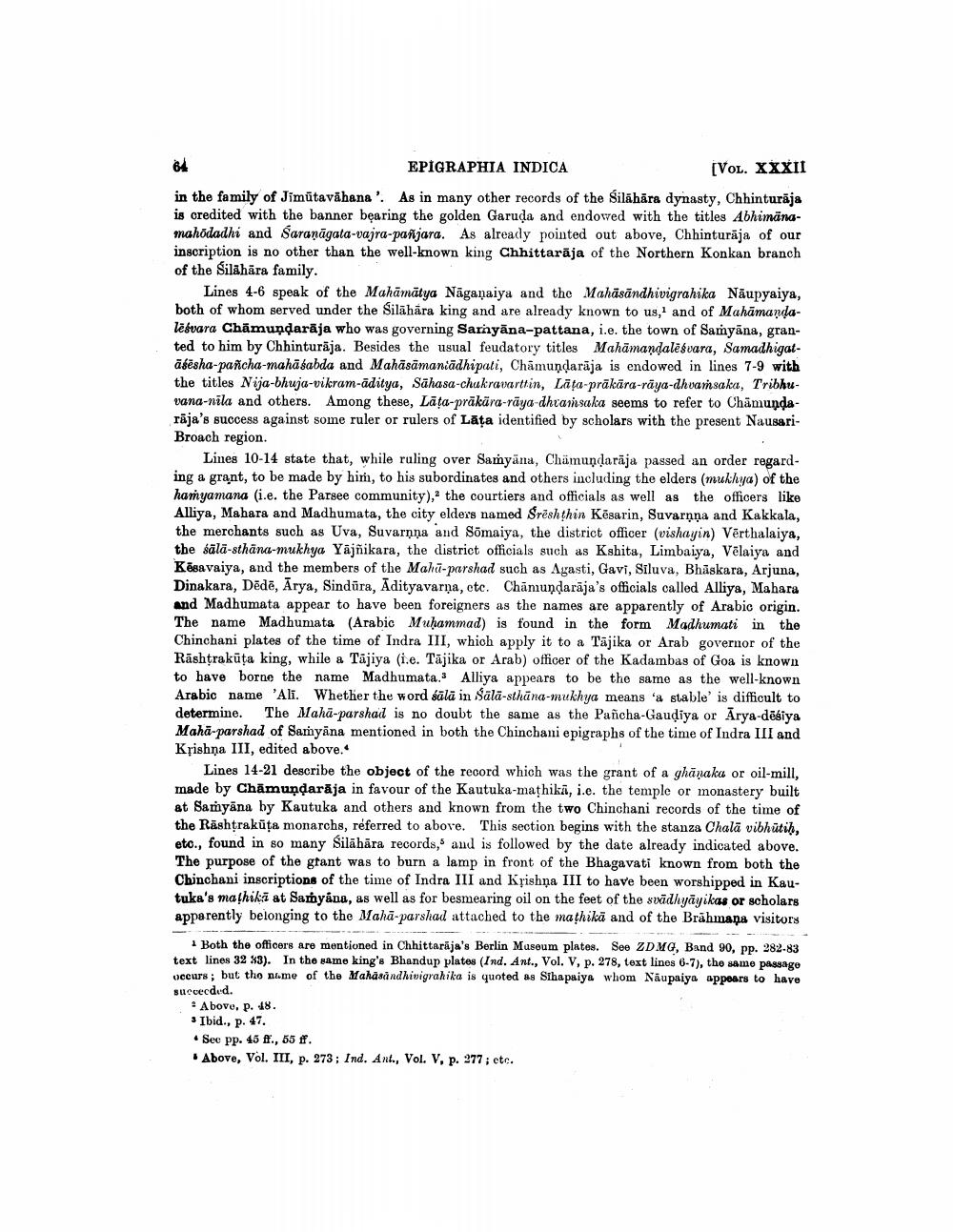________________
EPIGRAPHIA INDICA
(VOL. XXXII
in the family of Jimütavahana'. As in many other records of the Silähära dynasty, Chhinturaja is credited with the banner bearing the golden Garuda and endowed with the titles Abhimanamahodadhi and Saranāgata-vajra-pañjara. As already pointed out above, Chhinturaja of our inscription is no other than the well-known king Chhittarāja of the Northern Konkan branch of the Silahāra family.
Lines 4-6 speak of the Mahāmātya Nāganaiya and the Mahäsāndhivigrahika Näupyaiya, both of whom served under the Šilāhāra king and are already known to us, and of Mahamandaledvara Chamundarāja who was governing Sarayāna-pattana, i.e. the town of Samyāna, granted to him by Chhinturäja. Besides the usual feudatory titles Mahamandalesvara, Samadhigatāsësha-pancha-mahāsabda and Mahāsāmaniādhipati, Chamundarāja is endowed in lines 7-9 with the titles Nija-bhuja-vikram-āditya, Sāhasa-chakravarttin, Läta-prākāra-raya-dhvamsaka, Tribhuvana-nila and others. Among these, Lata-prākāra-raya-dhrannsaka seems to refer to Chamundarāja's success against some ruler or rulers of Lăța identified by scholars with the present NausariBroach region.
Lines 10-14 state that, while ruling over Samyana, Chämundarāja passed an order regarding a grant, to be made by him, to his subordinates and others including the elders (mukhya) of the hamyamana (i.e. the Parsee community), the courtiers and officials as well as the officers like Alliya, Mahara and Madhumata, the city elders named Srështhin Kesarin, Suvarnna and Kakkala, the merchants such as Uva, Suvarnna and Somaiya, the district officer (vishayin) Vērthalaiya, the sälā-sthāna-mukhya Yajñikara, the district officials such as Kshita, Limbaiya, Velaiya and Kēsavaiya, and the members of the Mahū-parshad such as Agasti, Gavi, Siluva, Bhaskara, Arjuna, Dinakara, Dēdē, Ārya, Sindūra, Adityavarņa, ctc. Chāmundarāja's officials called Alliya, Mahara and Madhumata appear to have been foreigners as the names are apparently of Arabic origin. The name Madhumata (Arabic Muhammad) is found in the form Madhumati in the Chinchani plates of the time of Indra III, which apply it to a Tajika or Arab governor of the Rashtrakūta king, while a Tajiya (i.e. Tājika or Arab) officer of the Kadambas of Goa is known to have borne the name Madhumata. Alliya appears to be the same as the well-known Arabic name 'Ali. Whether the word sālā in Sālā-sthāna-mukhya means 'a stable' is difficult to determine. The Maha-parshall is no doubt the same as the Pancha-Gaudiya or Arya-dësiya Maha-parshad of Samyana mentioned in both the Chinchani epigraphs of the time of Indra III and Krishna III, edited above.
Lines 14-21 describe the object of the record which was the grant of a ghāpaku or oil-mill, made by Chămundarāja in favour of the Kautuka-mathika, i.e. the temple or monastery built at Samyana by Kautuka and others and known from the two Chinchani records of the time of the Rashtraküța monarchs, referred to above. This section begins with the stanza Chalā vibhūtih, etc., found in so many Silāhāra records, and is followed by the date already indicated above. The purpose of the grant was to burn a lamp in front of the Bhagavati known from both the Chinchani inscriptions of the time of Indra III and Krishna III to have been worshipped in Kautuka's mathika at Samyana, as well as for besmearing oil on the feet of the svidhyāyikas or scholars apparently belonging to the Mahā-parshad attached to the mathikä and of the Brāhmana visitors
. Both the officers are mentioned in Chhittarāja's Berlin Museum plates. See ZDMG, Band 90, pp. 282-83 text lines 32 33). In the same king's Bhandup plates (Ind. Ant., Vol. V, p. 278, text lines 6-7), the same passage occurs; but the name of the Mahasåndhivigrahika is quoted as Sihapaiya whom Näupaiya appears to have sucoecded.
. Above, p. 48. * Ibid., p. 47. . See pp. 45 ft., 55 ff. . Above, Vol. III, p. 273; Ind. Ant., Vol. V, p. 277 ; etc.




